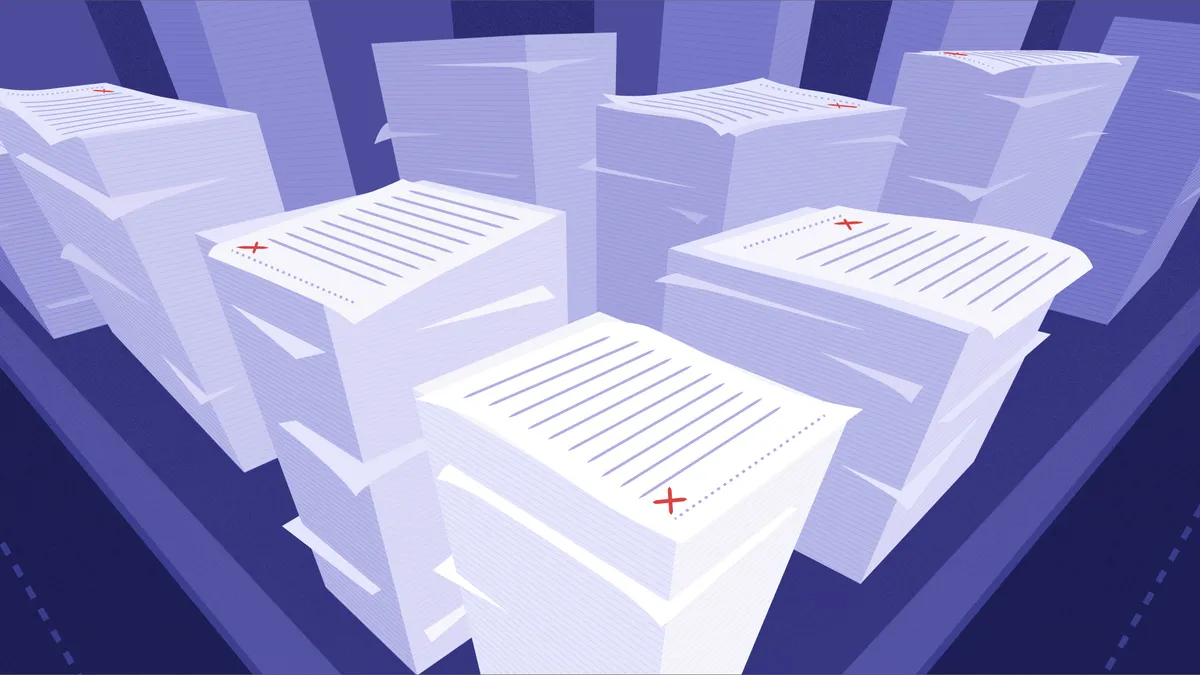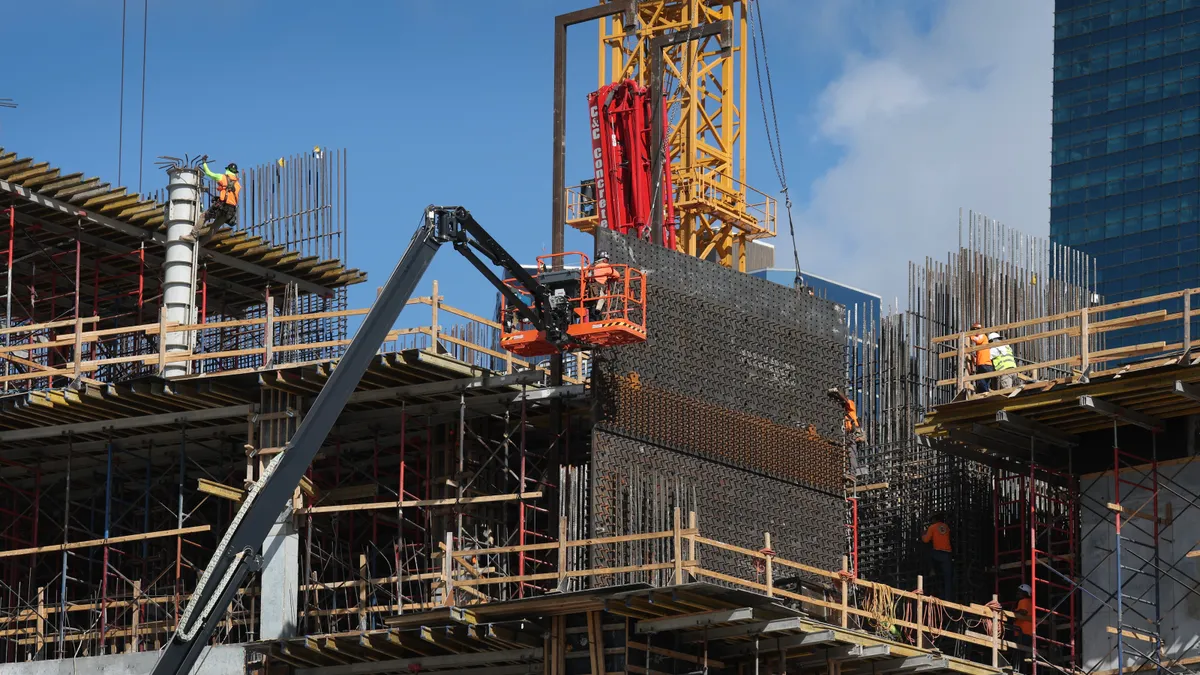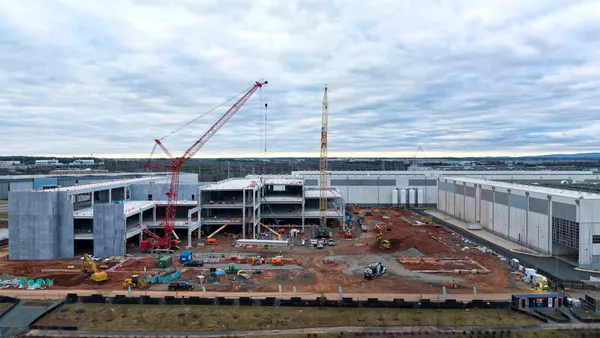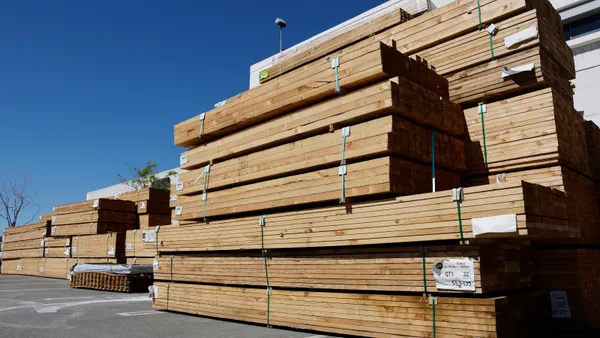This feature is a part of “The Dotted Line” series, which takes an in-depth look at the complex legal landscape of the construction industry. To view the entire series, click here.
Contractors are bracing for a fresh wave of material price hikes as President Donald Trump’s new and proposed tariffs fuel concerns across the construction industry.
Similar policies enacted during Trump’s first term caused benchmark steel prices to jump 14% before settling at a 10% increase by the end of 2019. Now, with nonresidential construction spending already slipping and material costs climbing ahead of new tariffs, contractors are once again weighing how to protect themselves from sudden price swings.
This time, contractors have a playbook for how to respond.
During the height of the COVID-19 pandemic, construction pros experienced firsthand how price volatility could wreak havoc on budgets. Many pushed for material escalation clauses in contracts, which allow for adjustments in pricing due to market volatility.
Despite initial resistance, the pandemic pushed some owners to ultimately accept these provisions, setting a precedent contractors may attempt to build upon in the coming years, said Matthew Long, construction partner at Cohen Seglias, a Philadelphia-based law firm.

“Material price increase terms became more common during the first Trump administration, and were ubiquitous during the pandemic,” said Long. “During that time, owners were generally forced to accept these terms. Contractors have continued to request material price escalation terms in recent years, with less success.”
Long said he anticipates a resurgence in material price escalation terms during the second Trump administration. In fact, many industry standard contracts, such as those from ConsensusDocs, now include addendums for material price escalation, said Zack Rippeon, a partner in the Atlanta office of law firm Smith Currie Oles.
“The word ‘tariff’ probably doesn’t exist in any standard form contracts,” said Rippeon. “But the concept of material escalation is absolutely something that is discussed and negotiated.”
A question of money and time
David Suchar, a partner at Maslon, a Minneapolis-based law firm, noted while standard industry contracts often do not address tariffs, contractors can still protect themselves.
“Construction contracts can address issues associated with tariffs” via escalation provisions, said Suchar. “They would typically allow contractors to seek additional compensation if tariffs cause increases in costs for certain project materials.”
Nevertheless, Rippeon added that tariffs, beyond driving up costs, also extend project timelines by delaying material deliveries. If a contractor is waiting on foreign-sourced materials that are now subject to tariffs, they could face schedule overruns.
“It’s not just about the money — even if I can pay more or have an avenue to have somebody reimburse me that money, how much longer is it now going to take me to get that material?” said Rippeon. “So, I think the protections for contractors need to focus on both, not just on the cost impact of tariffs, but also the cost on time impact.”
Other useful clauses
Another common approach to mitigating the effects of tariffs is to use change-in-law clauses, said James Doerfler, partner in the project and construction group at Reed Smith, a Pittsburgh-based law firm.

“If you’re a contractor and you had a new tariff that was enacted after the contract was implemented, you would look to your contract to see whether or not the tariff would qualify as a change-in-law,” said Doerfler. “Similarly, you would look at the force majeure provision to see whether or not it fits as a way of justifying a change order.”
Force majeure clauses cover unforeseen events that make performance impossible or excessively costly. Some contractors may argue that tariffs meet this threshold, but whether a court or owner will agree is a separate matter, said Monica Dozier, partner at Bradley, a Birmingham, Alabama-based law firm.
“Tariffs are generally considered import taxes,” said Dozier. “Contractors should pay close attention to contract terms regarding tax responsibility, changes in law and even force majeure events to understand their potential rights and remedies in the event of a change in tariffs.”
Suchar warned against relying too heavily on force majeure clauses, as they are typically limited in scope and often only provide schedule relief, rather than additional compensation.
“Parties sometimes turn to force majeure clauses for cost increases after the fact but this is not a preferred route,” said Suchar. “It is more effective to describe the potential issue and deal with it specifically. Force majeure clauses also often allow only for extensions of time and not additional compensation.”
The most obvious solution — writing tariff-related clauses into contracts — is a tough sell, said Rippeon. Owners have historically rejected these provisions, arguing they introduce cost uncertainty and risk to their budgets, said William Thomas, a construction attorney at St. Louis-based law firm Gausnell, O’Keefe & Thomas and chair of the International Association of Defense Counsel’s construction law and litigation committee.
Even if a contractor insists on a tariff-related protection clause, owners may simply choose another bid without one. These types of clauses would also often require contractors to build in so much of a cost cushion they would no longer be the lower bidder, said Andrew Richards, co-chair of the construction practice group at Kaufman Dolowich, a Woodbury, New York-based law firm.
What type of contract is best?
Contracts with contingencies and allowances allow for adjustments in material pricing, said Colm Nelson, chair of the real estate industry group at Stoel Rives, a Portland, Oregon-based law firm.
“A lot of construction contracts are guaranteed maximum price contracts. In those contracts, the contractor is paid based on cost, plus its fee, plus a contingency up to a guaranteed maximum price,” said Nelson. “So, one question is, ‘What is the contingency for, and can it be used for unexpected increases in tariffs?’ Use of contingency is a point of negotiation.”
Nelson also noted that allowances can be another tool to manage tariff-related cost fluctuations. If materials fall under an allowance, the contract price can move up or down based on real-time cost changes.
“If there’s an item, like a material in an allowance bucket, the contract price will go up and down depending on how much that price moves,” said Nelson. “It’s a way to give the contractor some room under the guaranteed maximum price contract, but not entirely risk free.”
Dozier agrees projects using cost-plus or guaranteed maximum price structures allow for cost adjustments under certain conditions. The Associated General Contractors of America recommends using cost-plus agreements in light of tariff uncertainty.
“Recently, many contractors have started negotiating express change order relief for changes in tariffs in construction contracts,” said Dozier. “Others have proposed incorporating price escalation rights tied to publicly-available commodities indices, or even open-book cost-plus procurement pricing terms.”

By contrast, lump-sum contracts, which set a fixed-price agreement for a project, leave contractors more exposed to material price volatility because they offer fewer avenues for cost adjustments, said Dozier. Stacy Bercun Bohm, construction practice co-chair at Akerman, noted specificity in contract language plays a key role in managing tariff-related risks, particularly in lump-sum agreements where owners aim to maintain fixed pricing structures.
“Greater specificity in price escalation clauses is better for contract interpretation,” said Bercun Bohm. “For example, when the basis of payment is a lump sum, owners prefer to describe the contract price as firm and not subject to increases for escalation, including tariffs.”
Alternative risk-sharing approaches
Some contractors, especially on large-scale projects, are pushing for different approaches. That includes owners experimenting with ways to distribute risk.
First, instead of awarding massive turnkey contracts, owners are splitting them into multiple jobs. That reduces financial exposure for any one party, said Doerfler.
“Owners are breaking up these very large projects into smaller pieces where they’re phasing it, dividing up the responsibility,” said Doerfler. “I would expect that the prospect of tariffs is going to further accelerate that trend.”
Another strategy involves risk-sharing agreements between contractors and owners to mitigate cost increases, said Rippeon. Instead of one party bearing the full brunt of rising material prices, owners may cover the first 5% to 10% of cost overruns, with contractors responsible for anything beyond that.
“Let’s agree that the first X percent of material cost overruns the owner will bear, and then the contractor eats the rest,” said Rippeon. “So, if steel goes up 20%, and the owner agrees to eat the first 5% to 10%, that gives the contractor some reassurance that they’re not going to have to eat it all.”

Risk allocation for tariffs is often negotiated between project stakeholders, with various strategies available to address potential cost increases. The extent to which contracts can shift these risks onto owners depends largely on contract terms and the leverage each party has in negotiations, said John Neary, construction practice co-chair at law firm Akerman.
“The risk allocation for tariffs is all part of the contract negotiation process between project stakeholders, and there are many ways parties can address this risk point in their contracts,” said Neary. “Contractors can absolutely be on the hook for price escalation caused by tariffs.”















